Practicing the CBSE Sample Papers for Class 12 Applied Mathematics Set 10 allows you to get rid of exam fear and be confident to appear for the exam.
CBSE Sample Papers for Class 12 Applied Mathematics Set 10 with Solutions
Time Allowed: 3 hours
Maximum Marks: 80
General Instructions:
- This question paper contains five sections A, B, C, D and E. Each section is compulsory.
- Section – A carries 20 marks weightage, Section – B carries 10 marks weightage, Section – C carries 18 marks weightage, Section – D carries 20 marks weightage and Section – E carries 3 case-based with total weightage of 12 marks.
- Section -A: It comprises of 20 MCQs of 1 mark each.
- Section – B: It comprises of 5 VSA type questions of 2 marks each.
- Section – C: It comprises of 6 SA type of questions of 3 marks each.
- Section – D: It comprises of 4 LA type of questions of 5 marks each.
- Section – E: It has 3 case studies. Each case study comprises of 3 case-based questions, where 2 VSA type questions are of 1
mark each and 1 SA type question is of 2 marks. Internal choice is provided in 2 marks question in each case-study. - Internal choice is provided in 2 questions in Section – B, 2 questions in Section – C, 2 questions in Section – D. You have to attempt only one of the alternatives in all such questions.
Section – A
All questions are compulsory. No internal choice is provided in this section
Question 1.
If 100 = x (mod 7), then the least positive value of x is: [1]
(A) 2
(B) 3
(C) 6
(D) 4
Answer:
(A) 2
Explanation: We know that,
a = b(mod c)
Then b is the remainder, when a is divided by c.
100 = x(mod 7)

Thus, x = 2
Question 2.
If a = b(mod n), then [1]
(A) a = a(mod n)
(B) b = a(mod n)
(C) b = b(mod n)
(D) None of these
Answer:
(B) b = a(mod n)
Explanation: Ifa = b(mod n)
then n | (a – b)
or, n | – (b – a)
or, n | (b – a)
or, b = a(mod n)
![]()
Question 3.
If a man rows 32 km downstream and 14 km upstream in 6 hours each, then the speed of the stream is: [1]
(A) 2km/h
(B) 1.5km/h
(C) 2.5 km/h
(D) 2.25 km/h
Answer:
(B) 1.5km/h
Explanation: Upstream speed = \(\frac { 14 }{ 6 }\) km/h
Downstream speed = \(\frac { 32 }{ 6 }\) km/h
Speed of the stream = \(\frac{\frac{32}{6}-\frac{14}{6}}{2}\) = \(\frac{\frac{18}{6}}{2}\)
= \(\frac { 18 }{ 6 x 2 }\) = \(\frac { 3 }{ 2 }\)
= 1.5 km/h
Question 4.
In a 2 km race, P can give Q a start of 200 m and R a start of 560 m. Then in the same race, Q can give R a start of: [1]
(A) 360m
(B) 380m
(C) 400m
(D) 430m
Answer:
(C) 400m
Expltination: Let P is complete the race 200o m
and Q is at 1800 m
and R is at 1440 m
In a race of 1800 m

Q gives R a start at = 1800 – 1440
= 360
1 m race = \(\frac { 360 }{ 1800 }\)
2000 m race = \(\frac { 360 }{ 1800 }\) x 2000
= 400 m
Question 5.
The following graph represents the inequality.[1]
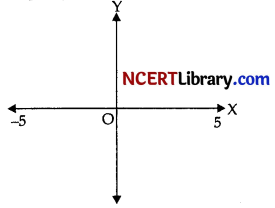
(A) x > – 5
(B) x < 5
(C) |x| < 5
(D) |x| < – 5
Answer:
(C) |x| < 5
Explanation: The given graph represents x > – 5
and x < 5 combining the two inequalities |x| < 5.
Question 6.
If C(x) and R(x) are respectively Cost function and Revenue function, then the Profit function P(x) is given by: [1]
(A) P(x) = R(x)
(B) P(x) C(x) + R(x)
(C) P(x) = R(x) – C(x)
(D) P(x) = R(x).C(x)
Answer:
(C) P(x) = R(x) – C(x)
Explanation: Profit is revenue minus cost
i.e., P(x) = R(x) – C(x)
![]()
Question 7.
Given that x = at2 and y = 2at, then value of \(\frac{d^2 y}{d x^2}\) is. [1]
(A) –\(\frac{1}{2 a t^3}\)
(B) –\(\frac{1}{2 a t^2}\)
(C) \(\frac{1}{t^2}\)
(D) \(\frac{-2a}{t}\)
Answer:
(A) –\(\frac{1}{2 a t^3}\)
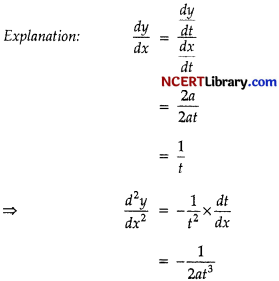
Question 8.
Which of the following values is used as a summary measure for a sample, such as a sample mean? [1]
(A) Popuiation Parameter
(B) Sample Parameter
(C) Sample Statistic
(D) Population mean
Answer:
(C) Sample Statistic
Question 9.
A is a statistical test used to compare the means of two groups [1]
(A) t-test
(B) p-test
(C) h-test
(D) g-test
Answer:
(A) t-test
Question 10.
Feasible region in the set of points which satisfy [1]
(A) The objective functions
(B) Some of the given constraints
(C) All of the given constraints
(D) None of the above
Answer:
(C) All of the given constraints
Question 11.
Moving average method is used for measurement of trend when: [1]
(A) Trend is linear
(B) Trend is non-linear
(C) Trend is curvilinear
(D) None of these
Answer:
(A) Trend is linear
Explanation: When trend is linear, then only we use moving average method for measurement.
![]()
Question 12.
An orderly set of data arranged in accordance with their time of occurrence is called: [1]
(A) Arithmetic Series
(B) Geometric Series
(C) Harmonic Series
(D) Time Series
Answer:
(D) Time Series
Explanation: The organized series of data on the basis of any measure of time is called Time series.
Question 13.
An observed set ofthe population that has been selected for analysis is called: [1]
(A) a sample
(B) a process
(C) a forecast
(D) a parameter.
Answer:
(A) a sample
Explanation: A selection of a group of individuals from a population in such a way that it represents the population is called as sample and the number of individuals in the sample is called the sample size.
Question 14.
The expectation of a random variable X (continuous or discrete) is given by …………….. [1]
(A) ∑X f (x), ∫X f(X)
(B) ∑X2f(X), ∫X2 f(X)
(C) ∑(X,), ∫f(X)
(D) ∑X f(X2), ∫X f(X2)
Answer:
(A) ∑X f (x), ∫X f(X)
Explanation: The expectation of a random variable X is given by the summation (integral) of X times the function in its interval. If it is a continuous random rarjable then summation is used and if it is discrete random variable, then integral is used.
![]()
Question 15.
An automatic machine produces 20000 pins per day. On rare occasion it produces a perfect pin whose chance is \(\frac { 1 }{ 10000 }\). Assuming Poisson distribution, the mean and variance of the number of perfect pins are …………… and ………., respectively [1]
(A) \(\sqrt{2}\), \(\sqrt{2}\)
(B) 2, 2
(C) 2, 4
(D) 4, 2
Answer:
(B) 2, 2
Explanation: For Poisson distribu 6on
Mean = variance
= np
= 20000 x \(\frac { 1 }{ 10000 }\)
= 2
Question 16.
The present value of a Sequence of payment of ₹1000 made at the end of every 6 months and continuing forever, if money is worth 8% per annum compounded semi-annually is: [1]
(A) 1000
(B) 2500
(C) 25,000
(D) 15,000
Answer:
(C) 25,000
Explanation: The given annuity is a perpetuity.
present value of perpetuity
![]()
Here, cash flow = ₹ 1000
interest rate = \(\frac { 8/2 }{ 100 }\)
= \(\frac { 4 }{ 100 }\) = 0.04
So, present value = \(\frac { 1000 }{ 0.04 }\)
= ₹ 25,000
![]()
Question 17.
Ass’ume that the year-end revenues of a business over a three period, are mentioned in the following table:

Calculate the CAGR of revenues’ over, three-years period spanning the “end” of 2018 to the “end” of 2021. Given that
\(\left(\frac{13}{9}\right)^{\frac{1}{3}}\) = 1.13. [1]
(A) 13%
(B) 14%
(C) 15%
(D) None of these
Answer:
(A) 13%
Explanation: The CAGR of the revenues over the three years period spanning the ‘end11 of 2018 to pend’ of 2021 is

= 1.13 – 1
= 0.13
= 13%
![]()
Question 18.
Reerna has an initial investment of ₹ 1,00,000 in an investment plan. After 5 years, it has grown to 2,00,000 then rate of return is: [1]
(A) 50%
(B) 100%
(C) 75%
(D) 200%
Answer:
(B) 100%
Explanation: Rate of Return
= \(\frac { 2,00,000 – 1,00,000 }{ 1,00,000 }\) x 100
= 100%
DIRECTION: For questions 19 and 20, two statements are given – one labelled Assertion(A) and the other labelled
Reason (R). Select the correct answer to these questions from the codes (A), (B), (C) and (D) as given below:
(A) Both assertion (A) and reason (R) are true and reason (R) is the correct explanation of assertion (A).
(B) Both assertion (A) and reason (R) are true and reason (R) is not the correct explanation of assertion (A).
(C) Assertion (A) is true but reason (R) is false.
(D) Assertion (A) is false but reason (R) is true.
Question 19.
Assertion (A): If a simple random sample consists of four observations 1, 3, 5, 7, then the point estimate of population standard deviation is 2.52. [1]
Reason (R): The point estimation of population standard deviation is sample deviation.
S = \(\sqrt{\frac{\left(x_i-\bar{x}\right)^2}{n-1}}\)
Answer:
Option (A) is correct.
Explanation: The point estimation of population standard deviation is sample deviation.
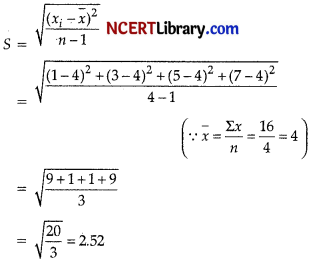
Question 20.
Assertion (A): A machine costing ₹ 50,000 has a useful life of 4 years. The estimate scarp value is ₹ 10,000, then the annual depreciation ia ₹ 10,000.
Reason (R): Annual depreciation

Answer:
Option (C) is correct.
Explanation: Annual depreciation
![]()
= \(\frac { 50,000 – 10,000 }{ 4 }\)
= \(\frac { 40,000 }{ 4 }\)
= ₹ 10,000
Section B
All questions are compulsory. In case of internal choice, aftempt any one question only
Question 21.
Tea worth ₹ 126 per kg and ₹ 135 per kg are mixed with a third variety in the ratio 1: 1: 2. If the mixture is worth ₹ 153 per kg, then find the price of the third variety in per kg. [2]
OR
Tap P alone fills a cistern in 2 hours; while tap Q alone fills the same cistern in 3 hours. A new tap R is attached to the bottom of the cistern which can empty the completely filled cistern in 6 hours. Sunny started all three taps together at 9 a.m. When will the tank be full?
Answer:
Since first and second varieties are mixed in equal proportions.
So, their average pnce = ₹ (\(\frac { 126 + 135 }{ 2 }\)) = ₹ 130.50
So, the mixture is formed by mixing two varieties, one at ₹ 130.50 per kg and the other at say ₹ x per kg in the ratio 2 : 2, i.e., 1 : 1. We have to find x. By the rule of alligation, we have:

∴ \(\frac { x – 153 }{ 22.50 }\) = 1
⇒ x – 153 = 1
⇒ x – 153 = 22.50
⇒ x = 175.50
∴ ₹ 175.50/kg
OR
Cistern filled or work done by Tap P in 1 hour = \(\frac { 1 }{ 2 }\)
Cistern filled or work done by Tap Q in 1 hour = \(\frac { 1 }{ 3 }\)
Tank emptied or work done by Tap R in 1 hour = \(\frac { 1 }{ 6 }\)
Tank filed or work done by all three pipes in 1 hour = \(\frac { 1 }{ 2 }\) + \(\frac { 1 }{ 3 }\) – \(\frac { 1 }{ 6 }\) = \(\frac { 2 }{ 3 }\)
So Tank gets completely filled in \(\frac { 3 }{ 2 }\) hours
= 1.5hours = 1 hr 30 min
So time will be 9.00 a.m. + 1 hour 30 min = 10.30 a.m.
Question 22.

Answer:
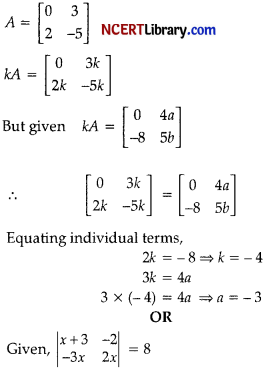
or 2x(x + 3) – ( – 2)( – 3x) = 8
or 2x2 + 6x – 6x = 8
or x2 = \(\frac { 8 }{ 2 }\)
or x2 = 4
or x = ± 2
Since x ∈ N, so, x = 2
![]()
Question 23.
A small firm manufactures necklaces and bracelets. The total number of necklaces and bracelets that it can handle per day is at most 24. It takes one hour to make a bracelet and half an hour to make a necklace. The maximum number of hours available per day is 16. If the profit on a necklace is ₹ 1oo and that on a bracelet is ₹ 300; Formulate a LPP for finding how many of each should be produced daily to maximize the profit? It is being given that at least one of each must be produced. [2]
Answer:
Let x be the number of necklaces manufactured and y be the number of bracelets manufactured. The total number of necklaces and bracelets it can handle is at most 24.
x + y ≤ 24
The x items takes x hours to manufacture and y items take \(\frac { y }{ 2 }\) hours to manufacture and the maximum time available is 16 hours. So,
x + \(\frac { y }{ 2 }\) ≤ 16
The profit on one necklace is given as ₹ 1oo and the
profit on one bracelet is given as ₹ 300.
Let the profit be Z. To maximize the profit,
Z = 100x + 300y
Therefore, the required is.
Max. Z = 100x + 300y
Subject to constraints,
x + y ≤ 24
x + \(\frac { y }{ 2 }\) ≤ 16
x, y ≥ 1
Question 24.
A company ABC Ltd has raised funds in the form of 1,000 zero-coupon bonds worth ₹ 1,000 each. The company wants to set up a sinking fund for repayment of the bonds, which will be after 10 years. Determine the amount of the periodic contribution if the annualised rate of interest is 5%, and the contribution will be done half-yearly. Given that (1.025)20 = 1.6386. [2]
Answer:
Sinking Fund, A = ₹ 1,00 x 1000 = ₹ 1,000,000, r = 5% or 0.05, No. of years, n = 10 years and No. of payments per year, m = 2 (Half Yearly)
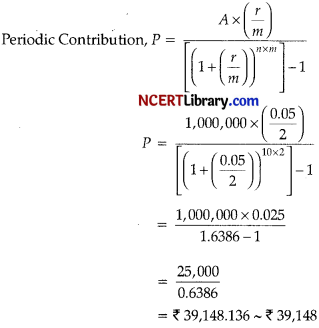
Therefore, the company will be required to contribute a sum of ₹ 39,148 half-yearly in order to build the sinking fund to repayment the zero-coupon bonds after 10 years.
Question 25.
₹ 5000 is invested in a Term Deposit Scheme that fetches interest 6% per annum compounded quarterly. What will be interest after one year? Given that (1.015)4 = 1.0613 [2]
Answer:
We know that,
Compound interest,
I = P[(1 + i)n – 1]
Here, P = 5000,
i = 6% p.a.
= 0.06 p.a.
= 0.06 x (1/4) per quarter
= 0.015 per quarter
I =5000[(1 + 0.015)4 – 1]
= 5000 {(1.015)4 – 1}
= 5000(1.0613 – 1)
= 5000 x 0.0613
= ₹ 306.50
∴ ₹ 306.50
Section – C
All questions are compulsory. In case of internal choice, attempt any one question only
Question 26.
If  showthat(A – 2I)(A – 3I) = 0. [3]
showthat(A – 2I)(A – 3I) = 0. [3]
Answer:
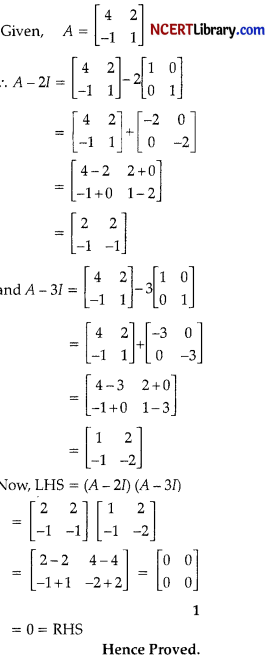
Question 27.
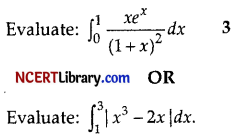
Answer:
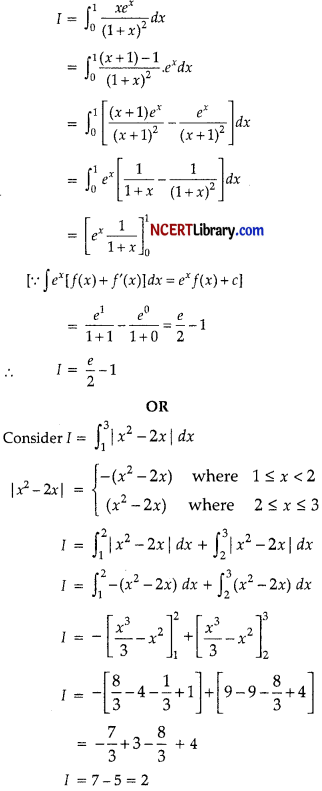
![]()
Question 28.
Form the differential equation of the family of circles in the second quadrant and touching the co-ordinate axes. [3]
OR
Find the particular solution of the differential equation: \(\frac { dy }{ dx }\) = 1 + x + y + xy given that y = 0 when x = 1.
Answer:
Equation of family of drcle is
(x + a)2 + (y – a)2 = a2
or x2 + y2 + 2ax – 2ay + a2 = 0
Differentiating, we get
2x + 2y \(\frac { dy }{ dx }\) + 2a – 2a \(\frac { dy }{ dx }\) = 0
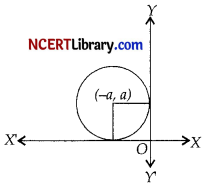
or x + y \(\frac { dy }{ dx }\) = a(\(\frac { dy }{ dx }\) – 1)
or a = \(\frac { x + yy’ }{ y’ – 1 }\)
where y’ = \(\frac { dy }{ dx }\)
Substituting the value of a in eqn. (i) and simplifying
(xy’ – x + x + yy’)2 (yy’ – y – x – yy’)2
= (x + yy’)2
or (x + y)2[(y’)2 + 1] = (x + yy’)2
OR
\(\frac { dy }{ dx }\) = 1 + x + y + xy
= (1 + x) (1 + y)
or ∫\(\frac { dy }{ 1 + y }\) = ∫(1 + x)dx
∴log |1 + y| = x + \(\frac{x^2}{2}\) +C
When, x = 1, y = 0 or C = – \(\frac { 3 }{ 2 }\)
∴Solution is:
log |1 + y| = x + \(\frac{x^2}{2}\) – \(\frac { 3 }{ 2 }\)
Question 29.
Find the intervals in which
f(x) = \(\frac { 3 }{ 10 }\)x4 – \(\frac { 4 }{ 5 }\)x3 – 3x2 + \(\frac { 36 }{ 5 }\)x + 11 is (a) strictly increasing (b) strictly decreasing. [3]
Answer:
f'(x) = \(\frac { 12 }{ 10 }\)x3 – \(\frac { 12 }{ 5 }\)x2 – 6x + \(\frac { 36 }{ 5 }\)
= \(\frac { 6 }{ 5 }\) (x – 1)(x + 2) (x – 3)
![]()
f'(x) = 0 at x = 1, – 2, 3
∴ Intervals are ( – ∞, – 2), ( – 2, 1), (1, 3) and (3, ∞)
∴f'(x) > 0 for ( – 2, 1) ∪ (3, ∞)
f(x) is strictly increasing in (- 2, 1) ∪ (3, ∞)
f’(x) < 0 for ( – ∞, – 2) and (1, 3)
f(x) is strictly decreasing in ( – ∞, – 2) ∪ (1, 3)
Question 30.
Rohan purchased a laptop worth ₹ 80000. He paid ₹ 20,000 as cash down and balance in equal monthly instalments
in 2 years. If bank charges 9% p.a. compounded monthly. Calculate the EMI. [Given (1.0075)24 = 1.1964] [3]
Answer:
Cost of laptop = ₹ 80,000
Down payment = ₹ 20,000
∴ Balance = ₹ 60,000
So, P = ₹ 60,000,
i = \(\frac { 9 }{ 12 x 100 }\)
= 0.0075
and n = 2 x 12 = 24
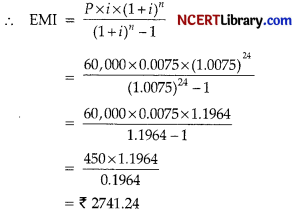
Question 31.
A company XYZ borrowed ₹ 1.5 lakhs for reformation. The company plans to set up a sinking fund that will pay back the loan at the end of 3 years. Assuming a rate of 9% compounded quarterly, and the sinking fund of the ordinary annuity. Given that (1.0225)12 = 1.3060. [3]
Answer:
Given, P = ₹ 1,50,000,
r = 9% or 0.09,
No. of years, n = 3 years
and No. of payments per year, m = 4(quarterly)
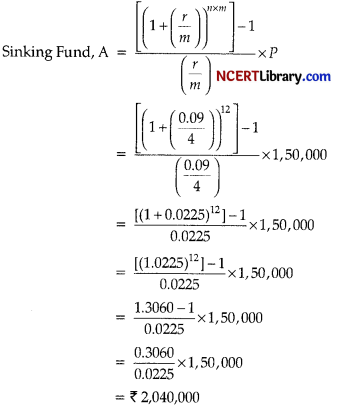
Section – D
All questions are compulsory. In case of internal choice, attempt any one question only
Question 32.
Express the matrix

as the sum of a symmetric and skew symmetric matrix. [5]
OR
Using properties of determinants, prove that:

Answer:

![]()
Question 33.
A cone is inscribed in a sphere of radius 12 cm. 1f the volume of the cone is maximum, find its height. [5]
A dosed right circular cylinder has volume \(\frac { 539 }{ 2 }\) cubic units. Find the radius and the height of the cylinder so that the total surface area is minimum.
Answer:
Let r be the radius of cone and h be the height of cone, let x be the distance between centre of sphere and centre of base of cone,
Given,
radius of sphere R = 12 cm
∴ h = 12 + x
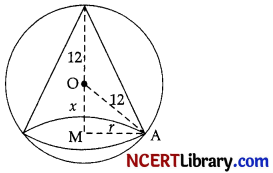
Volume of cone = \(\frac { 1 }{ 3 }\)πr2h
= \(\frac { 1 }{ 3 }\) π (122 – x2)(12 + x)
[∴ In ∆OMA, 122 = x2 + r2]
= \(\frac { 1 }{ 3 }\) π (144 – x2)(12 + x)
\(\frac { dV }{ dx }\) = \(\frac { 1 }{ 3 }\) π [(144 – x2).1 + (12 + x) (-2x)]
= \(\frac { 1 }{ 3 }\) π[14 – x2 – 24x – 2x2]
= \(\frac { 1 }{ 3 }\) π[144 – 24x – 3x2]
For maximum or minimum volume, put \(\frac { dV }{ dx }\) = 0
i.e., \(\frac { 1 }{ 3 }\) π[144 – 24x – 3x2] = 0
144 – 24x – 3x2 = 0
x2 + 8x – 48 = 0
(x + 12)(x – 4) = 0
x = – 12 and x = 4
Now,
(\(\frac{d^2 V}{d x^2}\)) = \(\frac { 1 }{ 3 }\) π [ – 24 – 6x]
∴(\(\frac{d^2 V}{d x^2}\))x=4 = \(\frac { 1 }{ 3 }\) π[ – 24 – 24] < 0
Hence, at x = 4 volume of cone is maximum and
height of cone (h) = 12 + x = 12 + 4 = 16cm.
OR
Let r be the radius and h be the height of the cylinder.
V = πr2 h = \(\frac { 539 }{ 2 }\)
⇒ h = \(\frac{539}{2 \pi r^2}\)
Let S be the total surface area, then
S = 2πr2 + 2πr2
= 2πr\(\frac{539}{2 \pi r^2}\) + 2πr2
= \(\frac { 539 }{ r }\) + 2πr2
\(\frac { dS }{ dr }\) = \(\frac{539}{2 \pi r^2}\) + 4πr2
For maximum or minima, \(\frac { dS }{ dr }\) = 0
⇒ – \(\frac{539}{2 \pi r^2}\) + 4πr2 = 0
⇒- 539 + 4πr2 = 0
⇒ r3 = \(\frac { 539 }{ 4π }\) = \(\frac { 539 x 7 }{ 4 x 22 }\)
⇒r3 = (\(\frac { 7 }{ 2 }\))3
⇒ r = \(\frac { 7 }{ 2 }\) units
∴\(\frac{d^2 S}{d r^2}\) = \(\frac{1078}{r^3}\) + 4π,

∴ S is minimum, at r = \(\frac { 7 }{ 2 }\) units
and h = \(\frac{539 x 7 x 2 x 2}{2 x 22 x 7 x 7}\)
Radius of the cylinder be \(\frac { 7 }{ 2 }\) units and height be 7 units.
Question 34.
What is the probability that a standard normal variate Z will be [5]
(i) greater than 1.09
(ii) less than – 1.65
(iii) lying between – 1.00 and 1.96
Answer:
(i) greater than 1.09 The total area under the curve is equal to 1, so that the total area to the right Z = 0 is 0.5 (since the curve is symmetrical). The area between Z = 0 and 1.09 (from tables) is 0.3621.
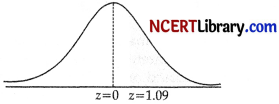
P(Z > 1.09) = 0.5000 – 0.3621
= 0.1379
The shaded area to the right of Z = 1.09 is the probability that Z will he greater than 1.09.
(ii) less than – 1.65 The area between – 1.65 and O is the same as area between O and 1.65. In the table the area between zero and 1.65 is 0.4505 (from the table). Since the area to the left of zero is 0.5, P(Z < 1.65) = 0.5000 – 0.4505 = 0.0495.
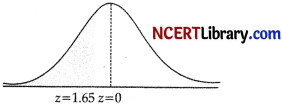
(iii) lying between – 1.00 and 1.96 The robabiIity that the random variable Z in between – 1.00 and 1.96 is found by adding the corresponding areas:
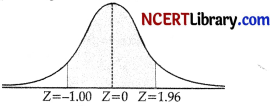
Area between – 1.00 and 1.96 = area between (- 1.00 and 0) + area between (0 and 1.96)
P(-1.00 < Z < 1.96) = P(- 1.00 < Z < 0) + P(0 < Z < 1.96)
= 0.3413 + 0.4750 (by tables)
= 0.8163
![]()
Question 35.
A dietician wishes to mix Iwo kinds of food X and Y in such a way that the mixture contains atleast 10 units of vitamin A, 12 units of vitamin B and 8 units of vitamin C. The vitamin contents of one kg food is given below:
| Food | Vitamin A | Vitamin B | Vitamin C |
| X | 1 Unit | 2 unit | 3 unit |
| Y | 2 unit | 2 unit | 1 unit |
One kg of food X costs ₹ 24 and one kg of food Y costs ₹ 36. Using Linear Programming, find the least cost of the total mixture which will contain the required vitamins. [5]
Answer:
Let x he the number of units of food X and y be the number of units of food Y he mixed to obtain the desired diet. Then LPP of the given problem is:
Minimise, Z = 24x + 36y
Subject to the constraints,
x + 2y ≥ 10, 2x + 2 ≥ 12
¡.e., x + y ≥ 6 and 3x + y ≥ 8
x ≥ 0, y ≥ 0
We draw the lines x + 2y = 10, x + y = 6, 3x + y = 8 and obtain the feasible region (unbounded and convex) as shown in the figure.
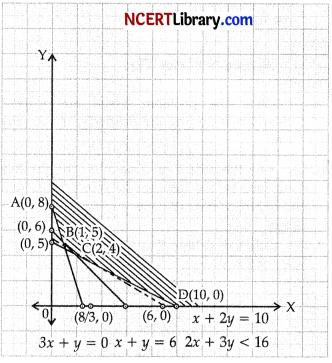
Thus, corner points are A(0, 8), B(1, 5), C(2, 4) and D(10, 0).
The values of Z(in ₹) at these points are given in the following table:
| Corner Point | Objective Function |
| A(0, 8)
B(1,5) C(2, 4) D(10,0) |
Z=24x+36y
Z = 24 x 0 + 36 x 8 288 Z = 24 x 1 + 36 x 5 = 204 Z = 24 x 2 + 36 x 4 = 192(Min.) Z = 24 x 10 + 36 x 0 = 240 |
As the feasible region is unbounded, we draw the graph of the half plane 24x + 36y < 192 i.e., 2x + 3y < 16 and note that there is no point common with the feasible region. The minimum value of Z is ₹ 192. It occurs at C(2, 4).
i.e., when 2kg of food X and 4 kg of food Y are mixed to get the desired diet.
Section – E
AH questions are compulsory. In case of internal choice, attempt any one question only
CASE STUDY- I
Question 36.
While making the notes on linear inequalities, Riya note down the following points in her notebook.
Inequality: Two real numbers or two algebraic expressions related by the symnol ‘<‘, ‘>’, ‘≤’, form an inequality.
Linear Inequality: An inequality is said to be linear, if each variable occurs in first degree only and there is no term involving the product of the variables.
e.g., ax + b ≤ 0, ax + by + c > 0, ax ≤ 4.
An inequality in one variable in which degree of variable is 2, is called quadratic inequality in one variable,
e.g., ax2 + bx + c ≥ 0, 3x2 + 2x + 4 ≤ 0.
Linear equality In one Variable: A linear inequality which has only one variable, is called linear inequality in one variable.
e.g., ax + b < 0, where a ≠ 0, 4c + 7 ≥ 0. (A) Rules of solving inequalities: If a ≥ b then a ± k ≥ b ± k where k is any number. If a ≥ b then ka is not always ≥ k – b If k > O (i.e., positive) then a ≥ b ⇒ ka ≥ kb
If k > O (i.e., negative) then a ≥ b ⇒ ka ≥ kb
Thus, always reverse the sign of inequality while multiplying or dividing both sides of an inequality by a negative number.
(B) Procedure to solve a linear inequality in one variable:
Simplify both sides by collecting like terms. Remove fractions (or decimals) by multiplying both sides by appropriate factor (LC.M. of denominator or a power of 10 in case of decimals.) Isolate the variable on one side and all constants on the other side. Collect like terms whenever possible. Make the coefficient of the variable equal to 1. Choose the solution set from the replacement set.
Solution set: A solution to an inequality is a number which when substituted for the variable, makes the inequality
true. The set of all solutions of an inequality is called the solution set of the inequality.
(i) Find the solution set for the following figure. [1]
![]()
(ii) Find the solution set for the following figure. [1]
![]()
(iii) Find the solution set for the given inequality. [2]
4x + 3 ≥ 2x + 17, 3x – 5 < – 2
OR
If |x + 2| ≤ 9, then find the solution set for x.
Answer:
(i) The given figure represents all value of x greater than 5 exduding 5 on the real number line.
So, x ∈ (5, ∞)
(ii) The given figure represent all real values of x less than and equal to – 2.
So x ∈ (- ∞, – 2].
(iii) We have,
4x + 3 ≥ 2x + 17
4x – 2x ≥ 17 – 3
2x ≥ 14
x ≥ \(\frac { 14 }{ 2 }\)
x ≥ 7
Also, we have 3x – 5 < – 2
3x < – 2 + 5
3x < – 2 + 5
3x < 3
x < 1
On combining Eqs. (i) and (ii), we see that solution is not possible because nothing is common between these two solutions,
(i.e.,x < 1, x ≥ 7).
OR
Given, |x + 2| ≤ 9
– 9 ≤ x + 2 ≤ 9
– 9 – 2 ≤ x ≤ 9 – 2
– 11 ≤ x ≤ 7
X ∈ [ – 11,7]
CASE STUDY-II
Question 37.
Today in mathematics class Mr. Lai teaches the topic of Binomial distribution. Four friends Rohan, Rohit, Roshan and Raman have few doubts in this topic, so they decided for group study at Rohan’s place. They are trying to solve a question in which a pair of dice is thrown 7 times. If getting a total 7 ¡s considered a success, then answer the following questions:
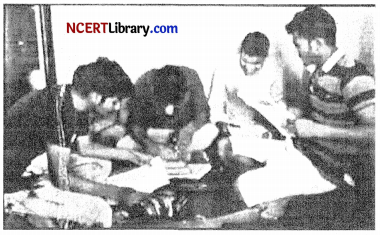
(i) If X denote the number of success in 7 throws of a pair of dice, then find parameters for X Binomial variate. [1]
(ii) What is the probability of no success? [1]
(iii) What is the probability of at least 6 success? [2]
OR
What is the probability of at most 6 success?
Answer:
(i) Let p denote the probability of getting a total of 7 in a single throw of a pair of dice. Then
p = \(\frac { 6 }{ 36 }\) = \(\frac { 1 }{ 6 }\)
[∵ The sum can be 7 in any one of the ways : (1, 6), (6, 1), (2, 5), (5, 2), (3, 4) and (4, 3)]
So, the parameters are:
n = 7 and p = \(\frac { 1 }{ 6 }\)
(ii) The X is a binomial variate with parameters n = 7 and p = \(\frac { 1 }{ 6 }\)
P (X = r) = 7Cr (\(\frac { 1 }{ 6 }\))r (\(\frac { 5 }{ 6 }\))7-r
r = 0, 1, 2,…… ………(i)
[∵q = 1 – p = 1 – \(\frac { 1 }{ 6 }\) = \(\frac { 5 }{ 6 }\)]
prohability of no success = P(X = O)
= 7C0 (\(\frac { 1 }{ 6 }\))0 (\(\frac { 5 }{ 6 }\))7-0
= (\(\frac { 5 }{ 6 }\))7
(iii) Probability of at least 6 success
= P(X ≥ 6)
= P(X = 6) + P(X = 7)
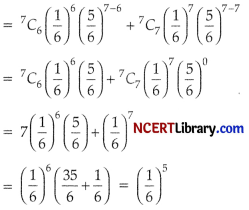
OR
From eq. (i),
Probability of at most 6 success = P(X ≤ 6)
= 1 – P(X > 6)
= 1 – P(X = 7)
= 1 – 7C7 (\(\frac { 1 }{ 6 }\))7 (\(\frac { 5 }{ 6 }\))7-7
= 1 – (\(\frac { 1 }{ 6 }\))7
![]()
CASE STUDY- III
Question 38.
To fit a straight line by the method of Least squares, Rohan constructed the following table:
| Year (t) | Profit (y) | x = ti – 2018 | x2 | xy |
| 2015 | 114 | – 3 | 9 | – 342 |
| 2016 | 130 | – 2 | 4 | – 260 |
| 2017 | 126 | – 1 | I | -126 |
| 2018 | 144 | o | o | o |
| 2019 | 138 | 1 | 1 | 138 |
| 2020 | 156 | 2 | 4 | 312 |
| 2021 | 164 | 3 | 9 | 492 |
The trend equation can be considered as yt = a + bx.
(i) Find the value of ‘a’ in the trend equation. [1]
(ii) Find the value of ‘b’ in the trend equation. [1]
(iii) Write the trend equation and find trend value of year 2015. [2]
OR
Find trend value of years 2018 and 2022.
Answer:
(i) a = \(\frac { ∑y }{ n }\)
Here,
n = 7 and ∑y = 972
So, a = \(\frac { 972 }{ 7 }\)
= 138.86
(ii) b = \(\frac{\Sigma x y}{\Sigma x^2}\)
Here,
n = 7, ∑xy = 214
and ∑x2 = 28
So, b = \(\frac { 214 }{ 28 }\)
= 7.64
(iii) Since, a = 138.86 and b = 7.64
Thus, trend equation is given by
y2 = 138.86 + 7.64x
For year 2015, x = – 3
∴ yt = 138.86 + 7.64 ( – 3)
= 115.94
OR
For year 2018, x O
∴ yt = 138.86 +7.64 (0)
= 138.86
For year 2022, x = 4
∴ yt = 138.8 + 7.64(4)
= 169.36